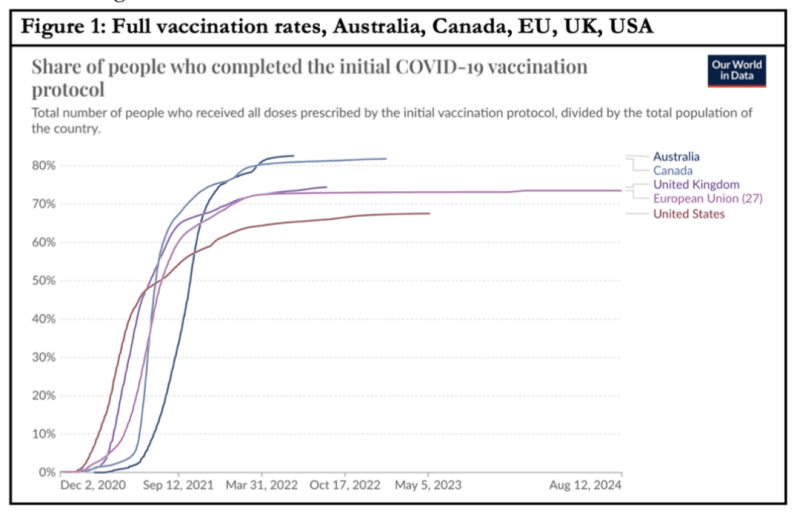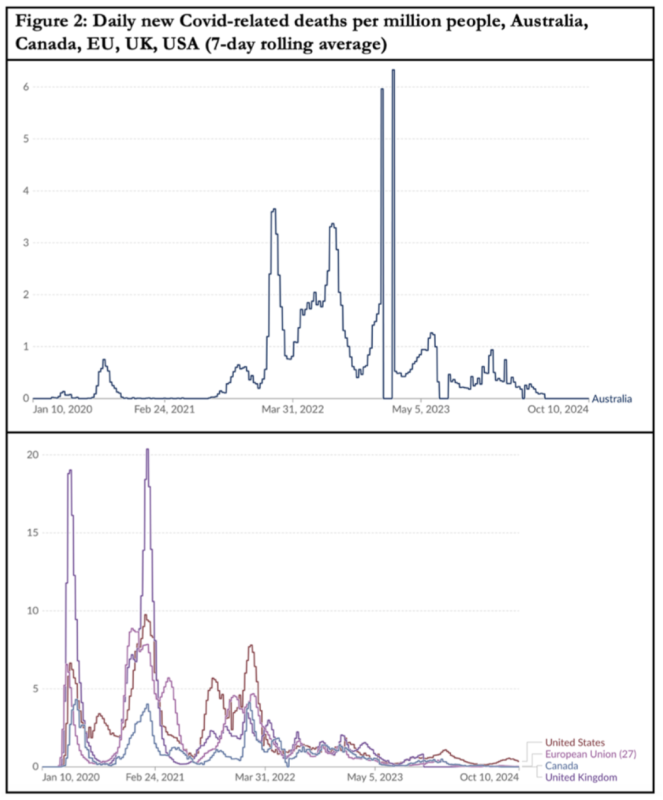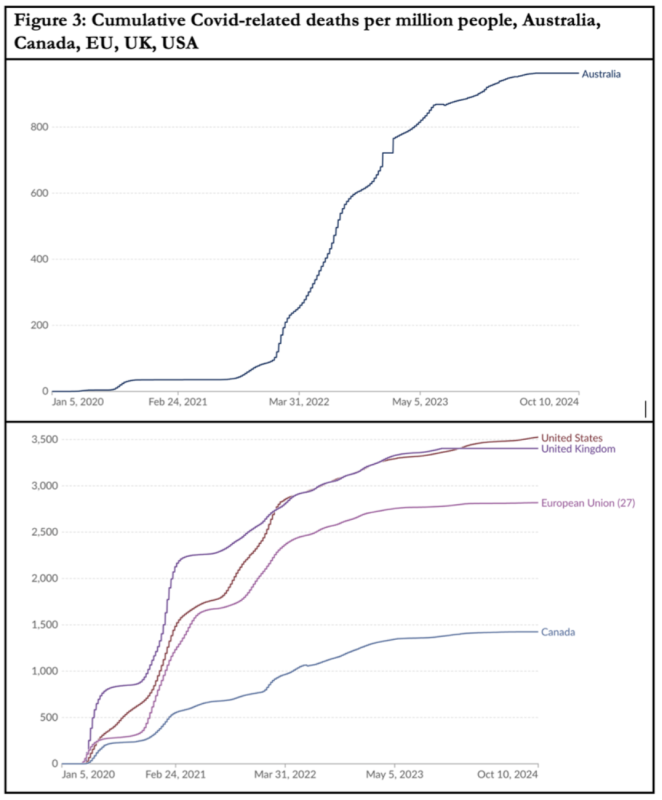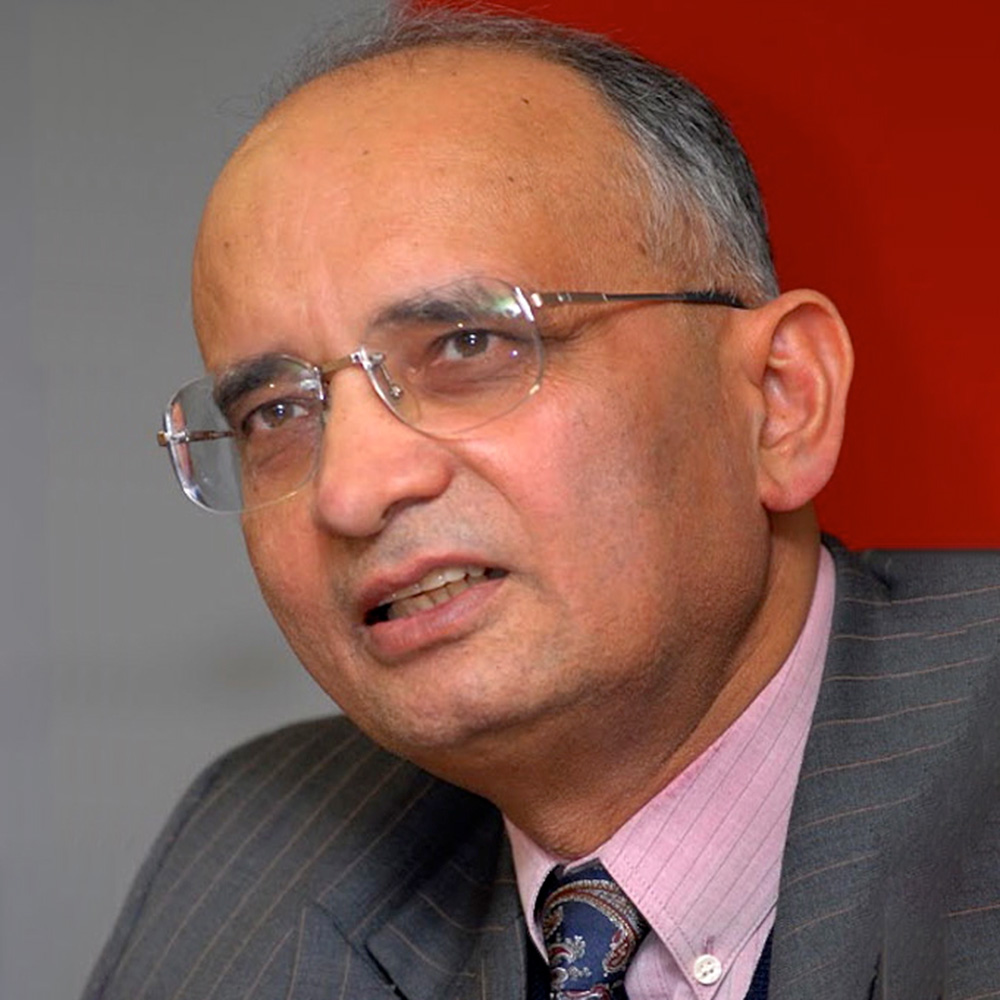On 24 October, Jay Bhattacharya, once derided by Anthony ‘Mr Science’ Fauci as a fringe epidemiologist, was awarded the Zimmer Medal for Intellectual Freedom by the American Academy of Sciences and Letters. The medal ‘is presented annually to a public thinker who displays extraordinary courage in the exercise of intellectual freedom.’ The 2023 winner was Salman Rushdie. Jay’s citation recognises his ‘courage and firm commitment to intellectual freedom’ who ‘resolutely refused…to compromise his scientific findings’ and took ‘a stand for the public’s right to unrestricted scientific discussion and debate.’
His writings and speeches are powerful examples of passion, courage, and clarity of expression that reflects clear thinking. He toured Australia in 2022 and I had the honour to share a packed town hall meeting with him in Melbourne on 22 September. Sadly but not surprisingly, his tour was mostly ignored by Australia’s mainstream media.
On 29 October, the official panel inquiring into Australia’s Covid-19 response submitted its 868-page report. I regret to say the report is not fit for purpose. Bottom line: This is a report of, by, and for the public health clerisy.
The prolix report is packed with turgid prose and bureaucratic analysis and recommendations. The Great Barrington Declaration of October 2020, co-authored by Bhattacharya, still offers better big-picture value in both language and content. The 513-word one page GBD might even profit PM Anthony Albanese to read, since during last year’s doomed campaign for the Voice referendum he let it be known that his attention span does not extend beyond the first page of a report and he sees no reason for it to do so. At the granular level, the report has some positive features but these are outweighed by flaws of commission and omission, much like the response to the pandemic itself.
Granted, the inquiry was hobbled by very tightly circumscribed terms of reference in yet another broken election promise that is itself destroying public trust in politicians and political institutions. Still, the panelists could have said no to the call to serve.
The report opens with virtue-signalling genuflections to political correctness. There is the ritualistic acknowledgment of ‘Traditional Owners and Custodians of Country throughout Australia on whose lands we all work, play and live,’ ‘their continuous connection to lands, waters, skies, culture and community’ and the ‘Aboriginal and Torres Strait Islander people’s significant contribution to society.’ The panelists pay ‘respects to their Elders past and present.’ The relevance of this to an inquiry report on Australia’s Covid response is difficult to discern. If this is a signal that henceforth, every official report is going to begin with these mantras then we can expect a significant and rapid rise of mainstream antagonism and resentment towards Aboriginal people.
Next, there is an acknowledgment of ‘lived experience:’ ‘We acknowledge that Covid-19 touched every person, every organisation and each sector,’ albeit ‘in different ways.’ Well, yes, that’s why the inquiry was set up, to determine the details and identify the impacts. To coin a phrase, this is a statement of the bleeding obvious.
This is topped off with a content warning: ‘This report contains material that may be distressing for some readers,’ complete with advice on who to contact for help. This was an inquiry into the Covid years that wrecked our lives, economy, and society for three years and counting. What did the panellists think readers would expect: lyrics to the latest kumbaya hymn? Instead of such mindless infantilisation, how about this:
‘We acknowledge the great loss of life, liberty, and happiness caused by Covid-19 and the response to it. We strongly recommend a Royal Commission of Inquiry to establish the division of causal responsibility between the disease and government policies, so that the perpetrators of mass public harms may be held accountable.’
Positives of Report Are Outweighed by Flaws
The report confirms that lockdowns, state border closures, school shutdowns, and vaccine mandates broke public trust in governments and science. They drove lower Covid vaccine takeup in the last two years and promoted cross-vaccine hesitancy. Inconsistent advice, recommendations, and enforcement practices across the states, compounded by the refusal to release health advice and its science and evidence base further eroded public trust.
The strong emphasis on human rights and the wider economic, social, and mental health consequences of the pandemic policies is also welcome. So too discussion of the long-term damage to children’s learning, development, and emotional health. All this is good, but neither particularly new nor insightful. Several critics warned about precisely these downstream consequences from day one.
The report ignores how Australia’s Covid response marked a radical departure from the prevailing consensus on science and policy as synthesised in the WHO September 2019 report. Nor is there any clarity on why Australia’s own existing pandemic preparedness plans were ditched.
Critical flaws of commissions begin with paeans to leaders’ courageous decision-making in conditions of mass fear and extreme uncertainty. The fear and hysteria did not match the data yet the government and media fed it. Experts who called for calm and responses that were proportionate to risks were ignored, censored, and vilified. Early data, including from the Diamond Princess cruise ship in February 2020 confirmed that the risk from Covid was highly age-correlated and concentrated in the elderly. There was no reason to strip peoples and businesses of their liberties and freedoms, to put healthy populations under wholesale house arrest, treating them as germ-ridden criminals even if proven innocent.
Far from courageous, the leaders were cowardly and hypocritical, or else just too credulous of what their expert advisers told them. They had no skin in the game, suffered no financial penalty while decimating small businesses, paid no political penalty, got sugar highs on power tripping, hid behind health officials, and typically exempted themselves from inconvenient restrictions they foisted on all others. Australians were prevented from returning home, diluting the quality of citizenship, and also from leaving the country.
But the prime minister was able to fly to the UK to attend the G7 summit (where he reversed Australian policy to commit Australia to Net Zero as the price of a guest seat at the exclusive high table), one state premier flew to Tokyo to lobby for hosting the Olympics, and one state chief health officer flew interstate to Canberra to attend an awards ceremony that recognised his stellar contribution to managing the pandemic.
Australia became fixated on the single, dubious metric of case numbers, exaggerating the Covid risks, downplaying the harms of interventions, heightening the fear, stripping people of rights and liberties, censoring dissent, and cancelling critics. Hard to believe, dozens of Victorian firefighters who were dismissed for being unvaccinated are still banned from work despite staff shortages as the fire season is about to start.
We threw extravagant and wasteful amounts of money at the problem. We sacrificed children’s futures for modest extensions to old people’s lives. Professor Margie Danchin, a consultant paediatrician at the Royal Children’s Hospital in Melbourne, says bluntly that ‘We punished kids to protect the adults.’ Has any society ever done this before?
The assumption of world-leading performance by Australia is rooted in simplistic and inappropriate European and North American benchmarks against which to assess our outcomes. Our Southern Hemisphere location, island identity, plentiful sunshine and open spaces, love of outdoors activities, relative paucity of high-density housing etc. conferred immense advantages in coming through the pandemic with much better outcomes than Europe and America.
The most visible embodiments of courage through the pandemic public policy insanity were Florida Governor Ron DeSantis and Sweden’s state epidemiologist Anders Tegnell. Florida and Sweden resisted the lockdown groupthink, are in the mid-range of Covid metrics, avoided most of the health, economic, educational, and social damage in European countries and US states with authoritarian approaches, including loss of public trust, and came out better on the balance of benefits versus harms.
The panelists betray astonishing, one-dimensional ignorance in their references to Sweden, as though we are still stuck in 2020 instead of having moved on to near the end of 2024. The only mentions of Sweden are by way of its significantly worse comparison in the first year of the pandemic. ‘Australia would have had between 15 and 46 times the number of deaths if it had experienced the same Covid-related death rates as comparable countries like Canada and Sweden’ as well as France, the UK, and the US.
The most striking variations in Covid mortality rates were by season (the Northern Hemisphere was much harder hit initially because of winter, giving a major seasonal buffer to countries in the Southern Hemisphere), geographical features like island identity and distance from Covid hotspots, and region.
Tegnell insisted that lockdowns lacked any ‘historical scientific basis.’ In July 2020, he rejected short-term performance measures and said judge me in a year. Sweden’s initial bad outcomes reflected the equivalent of the ‘dry tinder’ effect with low flu mortality in 2019, the mid-term school holiday calendar that saw many Swedes vacationing on Italian slopes at a particularly unfortunate time for the spread of the infection, and badly mishandled elderly patients in care homes. The better point of comparison for light-touch Sweden is the heavy-handed UK, whose Covid outcomes were worse.
Omissions Mean the Report Is Not Fit for Purpose
This section explores three important examples of where the inquiry fell short. In the first two on social distancing and facemasks, the non-pharmaceutical interventions departed radically from existing understandings with no scientific basis or evidence in justification.
In the third on vaccination, the response departed alarmingly from all established protocols governing the approval and authorisation of vaccines after duly completed trials to determine their efficacy and safety, not just in an immediate timeframe but over the long haul. To circumvent the full trials requirement, emergency use authorisation was necessary. This could not be done if existing treatment was available.
When physicians who claimed high success in clinical treatment of Covid patients with repurposed ivermectin and hydroxychloroquine were ordered by regulators to cease and desist, suspicions were fuelled about industry capture of the regulators. There is also a plausible argument that the legal framework governing the approval process in Australia should have been that for genetically modified organisms. This wasn’t done.
Social Distancing
‘Social distancing,’ the requirement that everyone must maintain the minimum specified distance from physical contact with any other human being, was a profoundly anti-social rule that severely disrupted social and economic functioning around the world for more than three years. On 31 May, the US Congress published the transcript of two days of testimony in January from Dr Anthony Fauci, the face of America’s Covid response.
On the second day of the closed-door testimony on 10 January, Committee Staff Director Mitch Benzine asked about the origins of the six-foot social distancing rule applied at businesses, schools, and all public settings. Fauci frankly admitted: ‘You know, I don’t recall. It sort of just appeared.’ Pressed on relevant ‘studies that supported six feet,’ he said ‘I was not aware of studies that – in fact, that would be a very difficult study to do’ (pp. 183–84).
As early as 25 April 2020, Professor Robert Dingwall, a scientific adviser to the UK government as a member of the New and Emerging Respiratory Virus Threats Advisory Group (NERVTAG), said there has ‘never been a scientific basis for two metres,’ it was ‘conjured up out of nowhere,’ and it should more accurately be called a ‘rule of thumb.’ He also warned that the social distancing measures would cause ‘serious damage to society, to the economy and to the physical and mental health of the population.’ Was he right, or was he right?
A group of Oxford University scientists explained in June 2020 that the science behind the social distancing rule was complex while the rule was starkly binary. It assumed that the sole or primary transmission route was through physical contact or large droplets. This also explained the early phobia about the constant use of hand sanitisers and disinfection of all potential contact surfaces like chairs and tables in restaurants and benches in parks. But the really small viruses can also be aerosolised and spread through the air.
Our chief health officers and ‘experts’ thus need to be interrogated on whether the adoption of the two-metre rule for Australia was an example of copycat idiocy or the persistence of culture cringe: where the Brits and Americans lead, we unquestioningly follow.
Facemasks
At the Congressional hearing on 10 January, Benzine also asked if a cost-benefit analysis had ever been done ‘on the unintended consequences of masking kids versus the protection that it would give them.’ ‘Not to my knowledge,’ Fauci conceded (p. 135).
Until 2020, ‘settled science’ was clear. Masks are ineffective. They stop neither infection nor transmission. The UK Influenza Preparedness Strategy 2011, reaffirmed on 27 February 2020, encapsulated the prevailing consensus (paragraph 4.15):
Although there is a perception that the wearing of facemasks by the public in the community and household setting may be beneficial, there is in fact very little evidence of widespread benefit from their use in this setting. Facemasks must be worn correctly, changed frequently, removed properly, disposed of safely and used in combination with good respiratory, hand, and home hygiene behaviour in order for them to achieve the intended benefit. Research also shows that compliance with these recommended behaviours when wearing facemasks for prolonged periods reduces over time.
This conclusion was reaffirmed in the WHO report published in September 2019 that summarised the best available studies to date, noting that ‘there is very little evidence of widespread benefit from their use in community and household settings. It was repeated by top WHO doctors Mike Ryan and Maria Van Kerkhove on 31 March 2020: ‘There is no specific evidence to suggest that the wearing of masks by the mass population has any potential benefit. In fact, there’s some evidence to suggest the opposite in the misuse of wearing a mask properly or fitting it properly.’
The benefits-harms equation for masks doesn’t compute, especially for children. They are dehumanising and a potent force for stoking mass fear. Facial expressions are crucial in social interactions, including for babies. And also for the elderly and people suffering from dementia in care homes. Consider this poignant testimony to Scotland’s Covid inquiry hearings from Alison Walker, a former BBC sports presenter, on 17 November 2023. Having witnessed the trauma of her 89- and 90-year old parents residing in care homes in 2020, she asked (around the 36-minute mark):
‘If you are surrounded by a group of people 24/7 wearing masks, and you don’t see people smile for up to two years, what kind of effect is that going to have on your mental health and wellbeing?’
Care homes abandoned their duty of ‘care and compassion,’ she believed, and instead ‘operated under a veil of fear’ (at 1:24:46). This was reinforced by the closing statement from the Care Home Relatives Scotland (paragraph 20):
‘The evidence demonstrated that the use of masks caused distress, confusion and considerable difficulties with communication. Residents couldn’t see smiles, had difficulty recognising relatives and those with hearing difficulties couldn’t lip-read or read facial expressions or visual clues.’
Masks also do cause some harms as side effects in some people. Compulsory masking for everyone in all settings is a gross violation of fundamental human rights. It can be justified only if the evidence for their efficacy in community protection is compelling and the risk of harms is negligible. Instead mask mandates were heavy on fear-mongering and virtue-signalling but light on data and science, overturning, in a couple of months, cumulative scientific consensus built over decades.
The report mentions masks several times, but only in the context of the inconsistent application of mandates. It doesn’t address the lack of high-quality studies and data that would contradict the pre-2020 consensus on their lack of efficacy in community settings, as confirmed in the Cochrane Review. It fails to tell us why Australia’s health authorities flipped on the old understandings.
Vaccines
Part of the explanation for the tone-deafness towards the still smouldering white-hot rage in the community is the failure to address the fiasco of the efficacy and safety of the vaccines.
From the start of vaccine rollout in February 2021 to 70 percent full vaccination on 21 November 2021, Australia’s total number of deaths was 1,187 (2,110-923) (Table 1). From initial rollout until 80 percent full vaccination on 20 March 2022, it was 5,599 (6,482-923). Since achieving those landmarks, which for practical purposes amount to full adult vaccination, the numbers of Covid-related deaths are 23,126 and 18,754, respectively.
There are two ways to put these figures in perspective. More than 25 times as many people have died with Covid-19 since 70 percent full vaccination compared to the total number before vaccination; and more than 20 times since 80 percent full vaccination than before vaccination.


That is, 91.6 and 74.3 percent of Australia’s Covid-related deaths occurred after 70 and 80 percent full vaccination, respectively. This contrasts with just 3.7 percent before the vaccines began to be rolled out. I really do hate to think what the statistics would be if vaccines were ineffective. And this is even without taking into consideration vaccine injuries or age-disaggregated Covid risks of hospitalisation and death for unvaccinated vs vaccinated and boosted healthy children, adolescents, and adults until age 60.


On 23 October, the BBC said that AstraZeneca vaccines had saved 6.3 million lives and Pfizer another 5.9 million, just in the first year from December 2020 to December 2021, including 120,000 British lives saved until September 2021. Looking at Figures 1–2, one can see why they would make such a claim. Yet as per Popperian falsifiability, just the one contrary example of Australia is sufficient to falsify the hypothesis of the Covid vaccines having saved millions of lives.
As can be seen in Figure 1, among the four countries plus the EU, Australia’s vaccine rollout was the last to begin yet the most rapid and successful of all five in covering the population. Figure 2 shows that Australia’s Covid mortality rate was above one death per million people almost continually for 17 months from 9 January 2022 to 23 June 2023, except for a brief period of three weeks in March–April 2023.




If we look at Figures 2 and 3 against the vaccination coverage in the five jurisdictions, two things become clear. For the four entities in the Northern Hemisphere, the heaviest Covid mortality toll both in terms of the daily count (Figure 2) and cumulatively (Figure 3) was in the first twelve months of the pandemic and the toll fell dramatically coinciding with the vaccine rollouts. For example, contrasting sharply with Australian data where the pre-vaccine deaths with Covid were under four percent of the total until October 2024, for the UK this was almost forty percent. Confusing correlation with causation, authorities, and vaccine-faithful advocates continue to attribute the fall to vaccines.
Yet, in the case of Australia, the relationship is reversed. Its Covid-related mortality rates and cumulative toll were exceptionally light in the first twelve months before the vaccine campaign was launched. For vaccine-sceptics, it’s tempting to attribute this to vaccines causing the explosion in deaths. Yet such a conclusion is contradicted by the experience north of the equator. Equally, however, the Australian (and New Zealand) experience refutes the hypothesis that vaccines saved millions of lives.
Instead, to my mind, taken together the divergent experiences powerfully indicate two alternative conclusions. Firstly, as was the case with lockdown restrictions and mask mandates, the rise and fall of the various coronavirus waves were policy-invariant, following a trajectory to some inner virus logic that was stubbornly indifferent to pharmaceutical and non-pharmaceutical interventions.
Second, population-level immunity acquired naturally through infection likely played a more critical role in getting to herd immunity than vaccines. This occurred much earlier in the UK, Europe, and America. Hard border closures in Australia (and New Zealand) kept the virus at bay until such time as borders were reopened in the wake of rapid and high vaccine uptakes. This finally seeded the virus in the population and infection, hospitalisation, and death rates rose sharply, herd immunity was achieved, and the virus receded. If this is so, then of course the benefit-harms equation for vaccines changes quite dramatically also.
To my absolute astonishment, the three words ‘cost-benefit analysis’ cannot be found even once in the more than 353,000 words of the report. The failure – nay, the cussed refusal – to engage in such analysis and publish the results, for an experimental product that may very well be contaminating our DNA (see Rebekah Barnett’s comprehensive refutation of the charge that this is misinformation), offers yet another bit of evidence that regulators have become vaccine enablers first, more committed to defending vaccines from criticism than protect people from harmful vaccines.
Conclusion
On the one hand, the report confirms how the policies implemented by political leaders acting under the guidance of public health officers and experts caused substantial health, mental health, economic, educational, and social damage that triggered a significant fall in trust in government and science.
On the other hand, the major solution to this problem recommended by the report is to increase the authority and resources of the same two groups (politicians and the public health bureaucrats) to control our behaviour in future health emergencies. The contradiction has been picked up by pretty much every commentator. Did none of the panelists notice the incoherence between analysis and recommendations?
The report vastly underrates public anger and cynicism. People were locked up at home on dubious data and science, forced to isolate from parents and grandchildren, unable to visit grandparents in their final days or attend family reunions, weddings, funerals, and birthdays, coerced into taking the shot in order to shop, travel, and keep jobs on false assurances of safety and effectiveness. Some of the worst offenders, responsible for the most egregious policies and thuggish enforcement measures, have been awarded the highest gongs going, promoted into governors’ mansions, and even promised a statue in their honour.
The report’s solution to the overreach and abuse of power by authorities during Covid is to create even more bureaucratic structures with more powers and resources, including an Australian Centre for Disease Control even as the US CDC sinks into ever greater disrepute by the month. Governments grabbed too much power, coming uncomfortably close to becoming police states. Who but the same experts would staff the Australian CDC? This could potentially include one of the panellists, Catherine Bennett, who is professor of epidemiology at Deakin University.
In an interview with SBS TV on 7 July 2022, she said, ‘We have to ensure people have all their recommended boosters because the booster…reduces the risk of serious illness quite dramatically.’ She also recommended ‘people wear face masks and maintain social distancing.’ It’s certainly not unknown for a government report to turn out to be a successful job application for one of the authors.
It would incense many if those guilty of the biggest assault on Australians’ health, political, and economic freedoms in the nation’s history were to be rewarded with increased powers and resources to serially indulge their inner bullies. Dealing with the past is a prerequisite for imposing justified punishment for crimes against the people, enabling closure for the many physical injuries and emotional trauma of the totalitarian responses, and deterring future wrongdoers. This report doesn’t take us far on the path we must but are yet to travel.
This article integrates and expands two articles published in the Spectator Australia on 6 November (online) and 9 November (in the magazine).
Join the conversation:


Published under a Creative Commons Attribution 4.0 International License
For reprints, please set the canonical link back to the original Brownstone Institute Article and Author.









